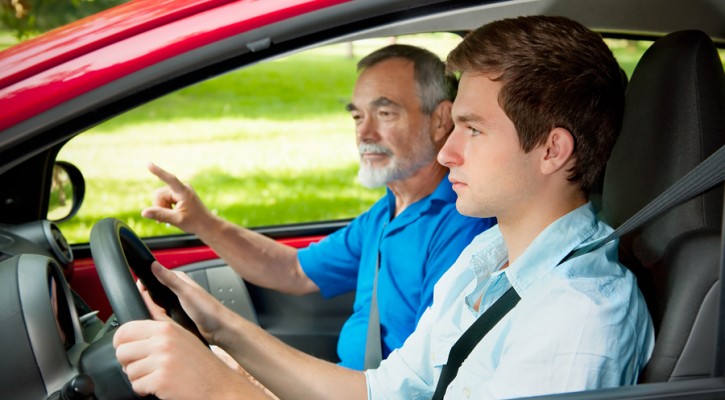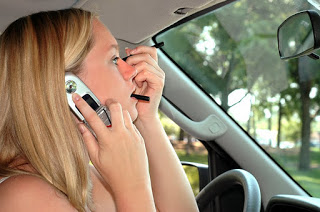Category Archive: Driving Skills

Driver Education: Traffic Safety for New High School Graduates
June 5, 2009
Summer is here and school is out. Many young drivers will be spending more time on the road going to the beach or pool, working at summer jobs, and having fun with friends. This is an especially exciting time for teens who are 2009 high school graduates. Recent grads are filled with elation, a sense of freedom, and hopes and dreams for the future. But euphoria and increased independence can cause problems when they lead relatively inexperienced drivers to take chances behind the wheel. And summertime is a dangerous time for drivers in general; traffic deaths for all drivers increase during the warm-weather months, peaking in July.
Three deadly holidays take place during the summer – Memorial Day, the Fourth of July, and Labor Day. According to the National Center for Statistics and Analysis, in a 2004 analysis of six holiday periods, the average number of traffic deaths during holiday periods was 156 per day, compared to 117 per day on non-holidays. According to the National Highway Traffic Safety Administration, 20 of the 25 deadliest days on US roads over a five-year time frame fell during the period from Memorial Day weekend to Labor Day.
Teen motor vehicle fatalities are also highest in the summer, partly because it’s an unsafe time for all drivers, but also due to risk factors specific to young drivers. Like other drivers, teens spend more time on the road during the summer (averaging 44% more hours driving each week, according to the NHTSA) and are more likely to drive at night. But they lack the experience of older drivers in dealing with heavy traffic and low-visibility conditions. Like other drivers, teens behind the wheel in the summer are often accompanied by multiple passengers. But teens are often much more distracted by their passengers than older drivers, and they are unlikely to assert themselves even when they are aware that they need to concentrate on driving.
Parents who want their teens to survive the summer must stay involved in their teens’ driving activities. Without close supervision, the vast majority of teens lack the emotional maturity to stay safe behind the wheel – or as passengers of other teen drivers.
-Though most parents will broaden driving privileges for summer, avoid giving teens too many privileges at once. Extend privileges one at a time and make sure teens prove they can handle the increased responsibility before adding more.
-Conduct supplementary driver training lessons. For example, many teens have limited experience with night driving during the school year; a few lessons will help them learn good nighttime driving habits from the beginning. A teen driving checklist helps parents provide valuable feedback on the driving lesson.
-A driver training course will help teens review fundamental driving concepts during a time when they are most at risk. A quick safe-driving refresher could help an inexperienced young driver make the right choice in an emergency. Parents whose teens receive even one traffic ticket must address the issue immediately; tickets mean teens are probably engaging in more risky driving behaviors than parents realize.
-Parents should check up on their teens’ seat belt use as often as possible. In 2006, the NHTSA reported that 58% of 16- to 20-year olds who were involved in fatal motor vehicle collisions were not wearing seat belts. The Insurance Institute for Highway Safety reports that teen seat belt use increases over time when strict parental limits are set.
-A heightened level of awareness about their teens’ access to alcohol, particularly on holidays, is critical for concerned parents. Teens may even have access to alcohol via their friends’ parents; ensure that teens understand that underage drinking is never acceptable, no matter what any other parent says or does, even for a special occasion. Create a codeword so your teen can ask to be picked up without risking the ridicule of friends.

Driver Education: Why New Drivers Should Take a Defensive Driving Class
May 27, 2009
Though teens receive driver training prior to being licensed and are subject to Graduated Driver Licensing laws to protect them from statistically high-risk driving situations, training shouldn’t end when teens get their licenses. Reasons for this include:
1. Newly licensed teenage drivers are often giddy with newly acquired freedom. They will assimilate more information once they have become accustomed to the increased level of independence they’ve earned.
2. Teens may pick up bad driving habits, such as carelessness and recklessness, from riding with other teens.
3. Teens who received defensive driving lessons prior to gaining driving experience often have difficulty applying those lessons until they are licensed.
4. New drivers often suffer from information overload; spreading driver training lessons out over time means they will retain more in the long run.
5. Though drivers are statistically less likely to be injured or killed in motor vehicle crashes as they leave their teens, the overall risk remains high throughout the teenage years when compared to other age groups.
Taking a defensive driving course six to twelve months after licensure is very helpful for new drivers. Teens can take the course online or in a classroom. Typical topics include:
- Crash statistics and the physics of vehicle crashes
- Crash prevention techniques
- Occupant protection devices (such as seat belts and airbags)
- Driving under the influence of alcohol
- How to share the road with large trucks, motorcyclists, and pedestrians
- Dealing with stress and drowsiness while driving
- The hazards of speeding
- An overview of traffic laws in your state
When teens take a defensive driving class, they have the opportunity to apply concepts that may have seemed abstract prior to licensure. For example, crash prevention techniques are easier to appreciate once the driver has experience in maneuvering a vehicle; unlicensed teens are unlikely to understand how much stress and sleepiness negatively impact their driving abilities. However, as newly licensed drivers, teens haven’t been driving long enough to have ingrained driving habits, so they still have an opportunity to eliminate unsafe practices and become safe drivers.

Driver Education: Teens and Defensive Driving
May 20, 2009
Teens are often urged to “drive defensively.” This is an excellent suggestion for any driver and is of particular importance to new drivers, who have limited experience in dealing with emergency situations and who are developing driving habits they may have for the rest of their lives. But what is defensive driving, exactly?
Driving defensively means driving in such a way that you reduce the risk of a crash, which will in turn prevent injury to yourself and others. It means going beyond following the rules of the road to put safety first. For example, if another driver is supposed to yield the right-of-way to you but fails to do so, as a defensive driver you will yield the right-of-way to that driver to avoid a collision.
Defensive driving isn’t just important in emergency situations, however. Using defensive driving techniques will help you:
- manage stressful driving conditions
- avoid traffic tickets
- keep your vehicle in good mechanical condition
- keep your driver’s license
There is no doubt that driving can be stressful, especially when traffic is heavy. One element of defensive driving is to maintain an adequate following distance from the vehicle in front of you. This decreases the risk of a rear-end collision if the vehicle ahead stops suddenly. Other ways to manage stress by driving defensively include:
- driving at a speed that is appropriate for conditions (which may be lower than, but is never higher than, the posted speed limit)
- checking intersections for cross traffic when you have a green traffic light (in case another driver runs the red light or a pedestrian is in the crosswalk)
- keeping a space cushion on all sides of your vehicle so you have room to maneuver if necessary
- watching the road ahead of your vehicle and checking your mirrors every three to five seconds so you notice hazards before they become a problem
Avoiding traffic tickets is especially important to drivers who are subject to a Graduated Driver’s Licensing program; these programs often restrict advancement to the next stage of licensure unless very few or no points accrue on the teen’s license. Traffic violations also mean hefty insurance increases for young drivers, who are already paying high rates because they are in a high-risk category. But following the rules of the road only when you’re worried about getting a ticket is not sufficient; if you’re not concentrating on driving defensively, you’re likely to make mistakes due to your reduced level of alertness. These mistakes could result in a ticket or even a crash, and even a minor fender-bender can result in points on your driving record.
Part of defensive driving is making sure that your vehicle is in good mechanical condition. Don’t wait for a breakdown to get your vehicle checked out; your owner’s manual offers a schedule of suggested maintenance tasks. Tires with low air or worn tread reduce your traction and make skids more likely. Your brakes need to be in top condition at all times. Even something as simple as not having windshield wiper fluid in the reservoir can impair your visibility and increase your chances of a crash. Don’t just put gas in the car and drive; take responsibility for ensuring that your vehicle is ready for the road.
As you’ve probably learned from your driver handbook, having a driver’s license is a privilege, not a right. This means that your driver’s license can be taken away, including for some non-driving offenses.
Driving defensively is part of an overall pattern of responsible behavior that will help you keep your license and the increased level of independence that comes with it.

The Importance of a Safe Driving Attitude
May 15, 2009
One important aspect of driver training is the development of a safe driving attitude. The reason a safe driving attitude is so important is because you will make many choices as you drive, and your driving choices have consequences. There are many benefits to a safe driving attitude, including:
- limiting stress while on the road
- saving you money on tickets and increased insurance costs
- helping you keep your driver license
- reducing your chances of being in a crash
To have a safe driving attitude, you must have control of your emotions and behavior, practice defensive driving techniques, and accept responsibility for all of your driving decisions.
Emotion is a word used to identify feelings such as anger, fear and joy. If you allow them to, emotions can change the way you assess risk and make driving decisions. When strong emotions such as anger affect you, your ability to make wise decisions may be reduced, increasing your chances of making a mistake. You may be so preoccupied with your anger that you misjudge the risks involved or don’t even notice important events in a particular driving situation.
Always be aware of your state of mind. Look at yourself objectively and decide if you really have the focus and alertness you need to safely use a motor vehicle. If you have any doubt, wait. Give yourself time to calm down and concentrate on safe driving. Learn more about how to avoid a road range incident.
You can expect some emotional stress in your everyday driving. Learning to manage it is important for your safety and the safety of others:
- If you are angry and excited, take a short walk, write your feelings down or talk to a friend before you get behind the wheel.
- No matter what is going on in your life, when you get behind the wheel, make a decision that until you arrive safely at your destination, you will focus on driving.
- Always allow plenty of time to get to your destination so you won’t get impatient with red lights or heavy traffic.
- Realize that many aspects of driving, such as heavy traffic and the actions of other drivers, are beyond your control. Stay calm when faced with stressful road conditions.
Part of having a safe driving attitude is consistently practicing defensive driving techniques:
- Make sure your vehicle is properly maintained
- Wear your safety belt and make sure your passengers do the same
- Choose a speed appropriate for conditions
- Make sure you have a space cushion all around your vehicle whenever possible
- Be alert and aware of the actions of all other road users, including motorcyclists, bicyclists, and pedestrians
- Watch the road ahead, behind and on both sides of your vehicle
- Anticipate problems early and select the best course of action in case the worst happens
- Give other drivers the benefit of the doubt when they make mistakes
Accepting responsibility for our decisions is an important part of becoming an adult. Willingness to do so demonstrates maturity and trustworthiness. When you drive, you must make sure you are willing to accept responsibility for all of your driving decisions. Other drivers cannot make you behave in one way or another; your reactions to their behavior are within your control. You must discipline yourself to put safety first no matter what any other driver does.
Developing a safe driving attitude is an important component of driver training; doing so from the beginning of your driving career will help keep you and others out of harm’s way on the road.

Teens and Distracted Driving
May 14, 2009
Car crashes are the number one killer of American teens, and the primary cause of fatal teen crashes is driver error. Driver distraction is included in the broad category of driver error. Though not every distracted teen driver is involved in a crash, distraction increases the risk of either causing a collision or being unable to avoid one. And though distracted driving is a problem for any driver, it is of special concern for inexperienced drivers, who may be distracted more easily and for longer periods of time and who may have difficulty controlling the vehicle even under normal conditions.
Modern diversions such as cell phones and other technical equipment are simply additions to traditional distractions such as eating, reading, dealing with passengers, reaching for objects, and looking at things or people outside of the vehicle. Dealing with passengers is one of the most frequently reported causes of distracted driving, and lively teen passengers can be particularly distracting to new drivers. Distracted driving is nothing new, but educational efforts to combat it are increasing.
It’s important to realize that when you’re driving, you’re already multitasking, because you are:
- Trying to control a large machine at high speed.
- Responding to the driving environment, including road and weather conditions, other traffic, and road signs and signals.
- Reacting to changing conditions, such as other drivers pulling out in front of you and pedestrians crossing the road ahead.
Adding another task to this list might be just enough to make you lose control of your vehicle or fail to act in time to prevent a collision.
The following tips will help prevent distracted driving:
- Increase your awareness of both physical and mental distractions. Physical distractions occur when you take your hands off the wheel and/or your eyes off the road. They happen when you adjust your stereo, take a drink of water, or reach for an object that has fallen on the floor. Mental distractions are sometimes more difficult to identify, because they don’t necessarily interfere with the physical act of driving. They occur when you argue or even laugh with a passenger, receive surprising or interesting news on your cell phone, or are preoccupied with a problem at school or work.
- Minimize the need for adjusting controls while you are driving. Take a few moments to prepare for your trip when you enter the vehicle. Adjust the seat position, climate control, stereo, and other devices before you leave your driveway or parking spot. If you are driving an unfamiliar vehicle, spend a few extra seconds locating the controls so you won’t need to look for them while you are driving.
- Review driving directions and maps, enter your destination into your navigation system and check traffic conditions before you leave. If you have a passenger, she or he can act as your navigator. Avoid sudden stop and turns while on the road by pulling over in a safe place, off the road and away from traffic, if you get confused or lost.
- Pull over to a safe place, off the road and away from traffic, to talk on the phone, text message or email. Using hands-free equipment is not safe enough because of the likelihood of mental distraction. Turn the phone off before you start out to reduce temptation.
- Stop at restaurants to eat or drink. Unwrapping food and condiment packages, reaching into bags, and having greasy fingertips are physical distractions. Realizing that you got the wrong sandwich is a mental distraction that is difficult to correct once you’ve left a drive-through window. Spilling coffee on your new shirt qualifies as both a physical and a mental distraction. Reduce your risk of a crash and your stress level by taking a few minutes to enjoy your meal outside of your vehicle.
- Keep in mind that your vehicle’s mirrors exist to help you view traffic, not yourself. Don’t use them for personal grooming while the vehicle is in motion.
As a driver, your only task when you enter your vehicle is to arrive safely at your destination. Anything else can be taken care of when you arrive. As a new driver, begin developing good habits right away by avoiding distractions and concentrating on your driving.
